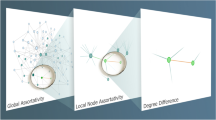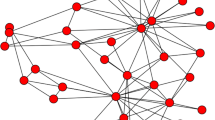Abstract
Since its introduction, the concept of assortativity has proved to be a fundamental metric for understanding the structure and function of complex networks. It has been shown to have a significant impact on many processes on networks, including epidemic thresholds, spreading, and longevity, congestion relief, and information cascades. In a number of these results, the degree distribution (usually a power-law distribution) plays a critical role. We describe a simple but effective method for modifying a given network so as to either increase or decrease its assortativity while preserving the degree distribution of the network. The process is easily controlled to yield desired assortativities. A modification is given which not only preserves the degree of every vertex but also respects a given community structure on the network. Both algorithms are supported by detailed empirical results. The constructions should be of particular value to investigators seeking to measure the impact of assortativity in various applications without disturbing the overall degree distribution or community decompositions.
Similar content being viewed by others
Explore related subjects
Discover the latest articles, news and stories from top researchers in related subjects.References
Albert, R., “Scale-free networks in cell biology,” Journal of cell science, 118, 21, pp. 4947–4957, 2005.
Badham, J. and Stocker, R., “The impact of network clustering and assortativity on epidemic behaviour,” Theoretical population biology, 77, 1, pp. 71–75, 2010.
Barabási, A.-L. and Albert, R., “Emergence of scaling in random networks,” Science, 286, 5439, pp. 509–512, 1999.
Barthélemy M, Barrat A, Pastor-Satorras R, Vespignani A: “Velocity and hierarchical spread of epidemic outbreaks in scalefree networks,”. Physical Review Letters 92(17), 178701 (2004)
Blondel V.D, Guillaume J.-L, Lambiotte R, Lefebvre E: “Fast unfolding of communities in large networks,” Journal of Statistical Mechanics:. Theory and Experiment 2008(10), P10008 (2008)
Brandes, U., Delling, D., Gaertler, M., Gorke, R., Hoefer, M., Nikoloski, Z. and Wagner, D., “On modularity clustering,” Knowledge and Data Engineering, IEEE Transactions on, 20, 2, pp. 172–188, 2008.
Clauset A, Newman M.E.J, Moore C: “Finding community structure in very large networks,” . Physical review E 70(6), 066111 (2004)
Crucitti, P., Latora, V., Marchiori, M. and Rapisarda, A., “Efficiency of scale-free networks: error and attack tolerance,” Physica A: Statistical Mechanics and its Applications, 320, pp. 622–642, 2003.
D’Agostino G, Scala A, Zlatić V, Caldarelli G: “Robustness and assortativity for diffusion-like processes in scale-free networks,” EPL . (Europhysics Letters.) 97(6), 68006 (2012)
Dezső Z, Barabási A.-L: “Halting viruses in scale-free networks,”. Physical Review E 65(5), 055103 (2002)
Ebel, H., Mielsch, L.-I. and Bornholdt, S., “Scale-free topology of e-mail networks,” arXiv preprint cond-mat/0201476, 2002.
Fortunato, S., “Community detection in graphs,” Physics Reports, 486, 3, pp. 75–174, 2010.
igraph. http://igraph.sourceforge.net.
Jeong, H., Tombor, B., Albert, R., Oltvai, Z. N. and Barabási, A-L., “The large-scale organization of metabolic networks,” Nature, 407, 6804, pp. 651–654, 2000.
May R.M, Lloyd A.L: “Infection dynamics on scale-free networks,”. Physical Review E 64(6), 066112 (2001)
Miller J.C: “Percolation and epidemics in random clustered networks,”. Physical Review E 80(2), 020901 (2009)
Moreno Y, Gómez J.B, Pacheco A.F: “Epidemic incidence in correlated complex networks,” . Physical Review E 68(3), 035103 (2003)
Newman M.E.J: “Finding community structure in networks using the eigenvectors of matrices,”. Physical review E 74(3), 036104 (2006)
Newman M.E.J., Girvan M.: “Finding and evaluating community structure in networks,” . Physical review E 69(2), 026113 (2004)
Newman M.E.J.: “Assortative mixing in networks,” . Physical Review Letters 89(20), 208701 (2002)
Onnela, J-P, Saramäki, J., Hyvönen, J., Szabó, G., Lazer, D., Kaski, K., Kertész, J., and Barabási, A-L., “Structure and tie strengths in mobile communication networks,” Proc. of the National Academy of Sciences, 104, 18, pp. 7332–7336, 2007.
Pajek. http://pajek.imfm.si.
Pastor-Satorras R., Vespignani A.: “Epidemic spreading in scale-free networks,” . Physical review letters 86(14), 3200 (2001)
Pastor-Satorras R., Vespignani A.: “Epidemic dynamics in finite size scale-free networks,” . Physical Review E 65(3), 035108 (2002)
Payne J. L., Dodds P.S., Eppstein M.J.: “Information cascades on degree-correlated random networks.” . Physical Review E 80(2), 026125 (2009)
Pons, P. and Latapy, M., “Computing communities in large networks using random walks,” in Computer and Information Sciences-ISCIS 2005, pp. 284–293, Springer, 2005.
r Project. http://www.r-project.org.
Raghavan U.N., Albert R., Kumara S.: “Near linear time algorithm to detect community structures in large-scale networks".. Physical Review E 76(3), 036106 (2007)
Redner, S., “How popular is your paper? an empirical study of the citation distribution,” The European Physical Journal B-Condensed Matter and Complex Systems, 4, 2, pp. 131–134, 1998.
Reichardt J., Bornholdt S.: “Statistical mechanics of community detection”. Physical Review E 74(1), 016110 (2006)
Rosvall, M., Axelsson, D. and Bergstrom, C. T., “The map equation,” The European Physical Journal Special Topics, 178, 1, pp. 13–23, 2009
Rosvall, M. and Bergstrom, C. T., “Maps of random walks on complex networks reveal community structure,” Proc. of the National Academy of Sciences, 105, 4, pp. 1118–1123, 2008.
Santos, F. C. and Pacheco, J. M., “Scale-free networks provide a unifying framework for the emergence of cooperation,” Physical Review Letters, 95, 9, 098104, 2005.
Singh B.K., Gupte N.: “Congestion and decongestion in a communication network”. Physical Review E, 71(5), 055103 (2005)
Toroczkai, Z. and Bassler, K. E., “Network dynamics: Jamming is limited in scale-free systems,” Nature, 428, 6984, p. 716, 2004.
Traag V.A., Bruggeman J.: “Community detection in networks with positive and negative links”.. Physical Review E 80(3), 036115 (2009)
Vazquez A.: “Spreading dynamics on small-world networks with connectivity fluctuations and correlations”.. Physical Review E 74(5), 056101 (2006)
Wang, X. F. and Chen, G., “Synchronization in scale-free dynamical networks: robustness and fragility,” Circuits and Systems I: Fundamental Theory and Applications, IEEE Transactions on, 49, 1, pp. 54–62, 2002.
Zhao, L., Park, K. and Lai, Y.-C., “Attack vulnerability of scalefree networks due to cascading breakdown,” Physical review E, 70, 3, 035101, 2004.
Author information
Authors and Affiliations
Corresponding author
About this article
Cite this article
Yang, R. Assortifying Networks. New Gener. Comput. 32, 297–308 (2014). https://doi.org/10.1007/s00354-014-0406-5
Received:
Revised:
Published:
Issue Date:
DOI: https://doi.org/10.1007/s00354-014-0406-5




